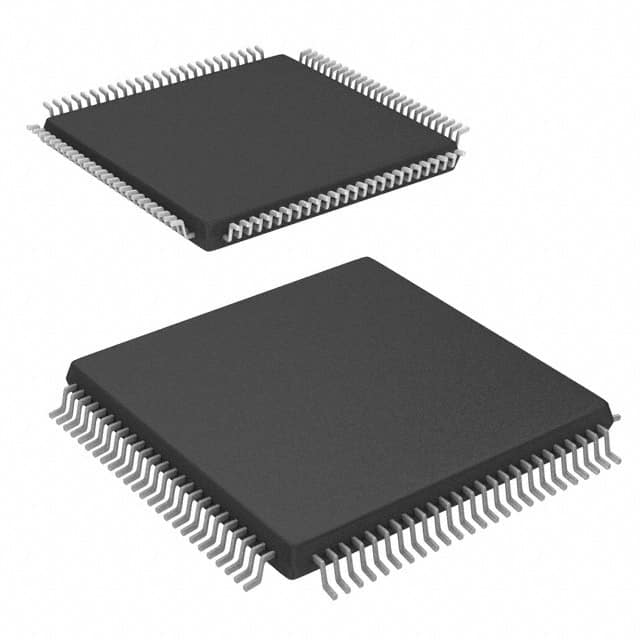Xem thông số kỹ thuật để biết chi tiết sản phẩm.

EPF6010ATC100-2
Product Overview
Category
The EPF6010ATC100-2 belongs to the category of programmable logic devices (PLDs).
Use
This product is primarily used in digital circuit design and implementation. It offers a flexible and customizable solution for various applications.
Characteristics
- Programmable: The EPF6010ATC100-2 can be programmed to perform specific functions, allowing for versatility in design.
- High-performance: It offers fast operation speeds and efficient processing capabilities.
- Reconfigurable: The device can be reprogrammed multiple times, enabling design modifications without hardware changes.
- Low power consumption: The EPF6010ATC100-2 is designed to minimize power usage, making it suitable for portable and battery-powered devices.
Package
The EPF6010ATC100-2 comes in a compact package that ensures easy integration into circuit boards. It follows the Thin Quad Flat Pack (TQFP) packaging standard.
Essence
The essence of the EPF6010ATC100-2 lies in its ability to provide a customizable and high-performance solution for digital circuit design.
Packaging/Quantity
This product is typically packaged in reels or trays, with each containing a specific quantity of EPF6010ATC100-2 units. The exact quantity may vary depending on the manufacturer's specifications.
Specifications
- Manufacturer: Intel
- Model: EPF6010ATC100-2
- Logic Elements: 6000
- Macrocells: 160
- I/O Pins: 100
- Operating Voltage: 3.3V
- Speed Grade: -2
- Package Type: TQFP
- Temperature Range: Commercial (0°C to 70°C)
Detailed Pin Configuration
The EPF6010ATC100-2 has a total of 100 I/O pins, each serving a specific purpose in the circuit design. The detailed pin configuration can be found in the product datasheet provided by the manufacturer.
Functional Features
- High-speed operation: The EPF6010ATC100-2 offers fast processing capabilities, making it suitable for applications that require quick response times.
- Flexible design: With its programmable nature, this PLD allows designers to create custom logic functions tailored to their specific requirements.
- Reconfigurability: The device can be reprogrammed multiple times, allowing for design modifications and updates without the need for hardware changes.
- Integration-friendly: The EPF6010ATC100-2 is designed to seamlessly integrate into existing digital circuits, enabling easy incorporation into various systems.
Advantages and Disadvantages
Advantages
- Versatility: The EPF6010ATC100-2's programmability enables it to adapt to different design needs, reducing the need for multiple specialized components.
- Cost-effective: By eliminating the need for dedicated hardware, this PLD reduces overall system costs.
- Time-saving: The reconfigurable nature of the device allows for faster prototyping and design iterations.
- Power efficiency: The low power consumption of the EPF6010ATC100-2 makes it suitable for battery-powered devices.
Disadvantages
- Learning curve: Utilizing the full potential of programmable logic devices may require additional knowledge and expertise.
- Limited complexity: While versatile, PLDs like the EPF6010ATC100-2 have limitations in terms of the complexity of designs they can handle compared to application-specific integrated circuits (ASICs).
Working Principles
The EPF6010ATC100-2 operates based on the principles of field-programmable gate arrays (FPGAs). It consists of configurable logic blocks (CLBs) interconnected through programmable interconnects. These CLBs contain look-up tables (LUTs) and flip-flops that can be programmed to implement desired logic functions.
Detailed Application Field Plans
The EPF6010ATC100-2 finds applications in various fields, including: 1. Telecommunications: Used in the design of communication systems, such as routers and switches. 2. Industrial automation: Employed in control systems for manufacturing processes and machinery. 3. Automotive electronics: Integrated into automotive systems for functions like engine control and driver assistance. 4. Consumer electronics: Utilized in devices like gaming consoles, digital cameras, and home appliances. 5. Medical equipment: Incorporated into medical devices for data processing and control functions.
Detailed and Complete Alternative Models
- EPF10K10TC144-3: A similar PLD with lower logic elements but suitable for less complex designs.
- EPF20K400CB652-2: Offers higher logic capacity and additional features for more demanding applications.
- EPF8282ATC100-4: A cost-effective alternative with lower power consumption but reduced performance capabilities.
These alternative models provide designers with options
Liệt kê 10 câu hỏi và câu trả lời thường gặp liên quan đến ứng dụng EPF6010ATC100-2 trong giải pháp kỹ thuật
Sure! Here are 10 common questions and answers related to the application of EPF6010ATC100-2 in technical solutions:
Q: What is EPF6010ATC100-2? A: EPF6010ATC100-2 is a field-programmable gate array (FPGA) manufactured by Altera (now Intel). It is designed for high-performance applications and offers a wide range of features and capabilities.
Q: What are the key features of EPF6010ATC100-2? A: Some key features of EPF6010ATC100-2 include 10,000 logic elements, 512 Kbits of embedded memory, 288 user I/O pins, and support for various communication protocols.
Q: What are the typical applications of EPF6010ATC100-2? A: EPF6010ATC100-2 can be used in a variety of applications such as telecommunications, industrial automation, medical devices, aerospace, and defense systems.
Q: How can EPF6010ATC100-2 be programmed? A: EPF6010ATC100-2 can be programmed using hardware description languages (HDLs) like VHDL or Verilog, which describe the desired functionality of the FPGA.
Q: Can EPF6010ATC100-2 be reprogrammed after deployment? A: Yes, EPF6010ATC100-2 is a field-programmable device, which means it can be reprogrammed even after it has been deployed in a system.
Q: What tools are available for programming EPF6010ATC100-2? A: Intel Quartus Prime software is commonly used for designing, simulating, and programming EPF6010ATC100-2 FPGAs.
Q: What is the power consumption of EPF6010ATC100-2? A: The power consumption of EPF6010ATC100-2 depends on the specific design and configuration, but it typically ranges from a few watts to tens of watts.
Q: Can EPF6010ATC100-2 interface with other components or devices? A: Yes, EPF6010ATC100-2 supports various communication protocols such as UART, SPI, I2C, Ethernet, and PCIe, allowing it to interface with other components or devices in a system.
Q: Are there any limitations or considerations when using EPF6010ATC100-2? A: Some considerations include the need for proper power management, thermal dissipation, and ensuring compatibility with other system components.
Q: Where can I find more information about EPF6010ATC100-2? A: You can refer to the official documentation provided by Intel (formerly Altera) or visit their website for detailed specifications, application notes, and reference designs related to EPF6010ATC100-2.

